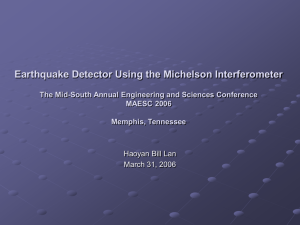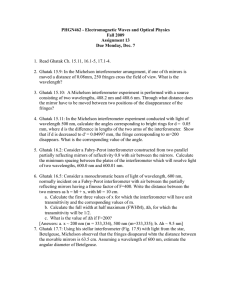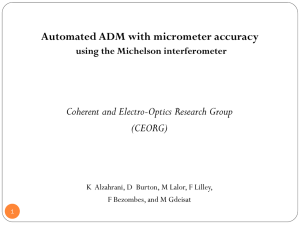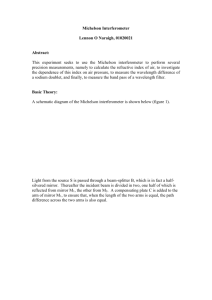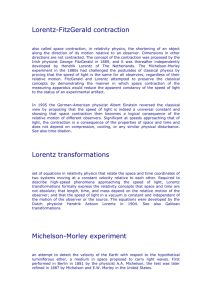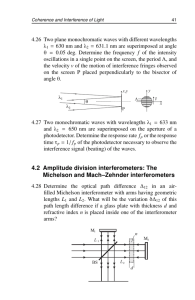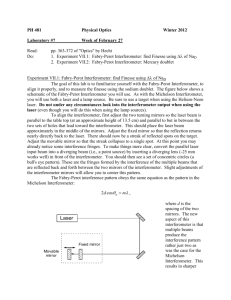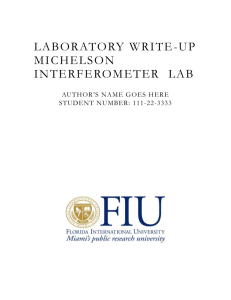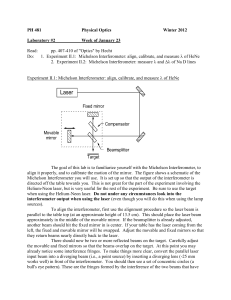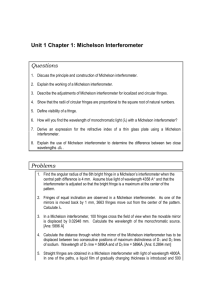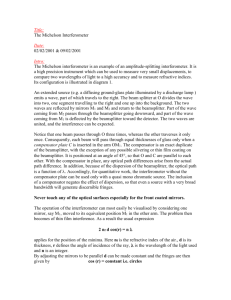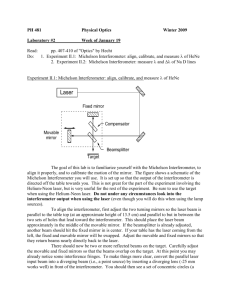Michelson interferometer
advertisement
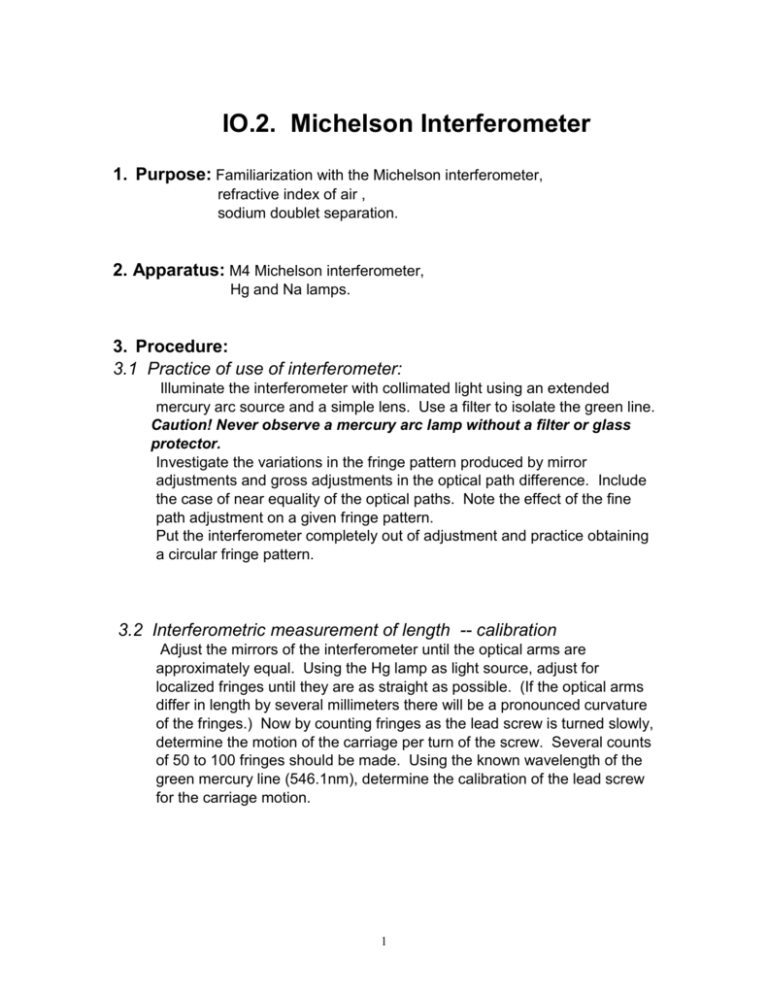
IO.2. Michelson Interferometer 1. Purpose: Familiarization with the Michelson interferometer, refractive index of air , sodium doublet separation. 2. Apparatus: M4 Michelson interferometer, Hg and Na lamps. 3. Procedure: 3.1 Practice of use of interferometer: Illuminate the interferometer with collimated light using an extended mercury arc source and a simple lens. Use a filter to isolate the green line. Caution! Never observe a mercury arc lamp without a filter or glass protector. Investigate the variations in the fringe pattern produced by mirror adjustments and gross adjustments in the optical path difference. Include the case of near equality of the optical paths. Note the effect of the fine path adjustment on a given fringe pattern. Put the interferometer completely out of adjustment and practice obtaining a circular fringe pattern. 3.2 Interferometric measurement of length -- calibration Adjust the mirrors of the interferometer until the optical arms are approximately equal. Using the Hg lamp as light source, adjust for localized fringes until they are as straight as possible. (If the optical arms differ in length by several millimeters there will be a pronounced curvature of the fringes.) Now by counting fringes as the lead screw is turned slowly, determine the motion of the carriage per turn of the screw. Several counts of 50 to 100 fringes should be made. Using the known wavelength of the green mercury line (546.1nm), determine the calibration of the lead screw for the carriage motion. 1 3.3 Measurement of the refractive index of air: Place the gas cell in uncompensated leg and pump it out (as far as you can; record the pressure P0 at which you stop the pump). Obtain a good circular fringe pattern. Leak air into the cell very slowly and count the fringe shift until atmospheric pressure Pa is reached. Compute the refractive index of air at the atmospheric pressure at the time of your measurement, and normalize it to “standard pressure”. Let ΔN be the fringe shift (i.e. number of transitions dark to dark or bright to bright at a reference point) when the gas pressure in the cell changes from P0 to Pa; Then the following relation holds (derive this as part of your write-up): 2(na - n0) L = λ ΔN, where n0 (na ) is the refractive index at pressure P0 (Pa), λ is the wavelength (in vacuum), and L is the geometrical length of the gas cell. From the Lorenz-Lorentz law follows that (n0 – 1)/(na – 1) = P0/Pa =:r (if the temperature is constant). This can be solved to yield na – 1 = λ ΔN/(2L(1-r)). You should do at least three repetitions of this measurement. Don’t forget to record the atmospheric pressure and temperature at the time of your measurement (best at beginning and end of each series). 3.4 Determination of the sodium doublet separation If an interferometer is used with two or more wavelengths as a source of radiation, a continuous change in the path difference of the interfering beam is accompanied by rhythmic changes in the contrast between the light and dark portions of the field, i.e. changes in the visibility. The visibility V is defined by the relation: V = (Imax - Imin)/(Imax + Imin) Graphic representations of the visibilities plotted as functions of the path difference are known as visibility curves. When the radiation employed is made up of only two narrow components the wavelength separation can be obtained quite accurately from the visibility curve. This can be done for the sodium doublet. The wavelength separation is given by: 2 Δλ= λ2/(2d) , where d is the distance between successive maxima or minima of the visibility curve, and λ the average wavelength of the doublet. The minima are the result of one set of fringe being in the middle of the second set. Adjust the interferometer such that there are about three or four circular fringes in the field of view. Measure the distance d by recording the positions of the lead screw between the successive maxima or minima of the fringe visibility. Using the average of several measurements, calculate the separation and compare this value with the value given in wavelength tables. 4. Analysis, write-up: 4.1 give a derivation of the equation used to determine the refractive index; state the assumptions that went into it. 4.2 assess the accuracy of your calibration --- determine (make an educated guess) how precisely you measure the quantities that go into the calculation of the calibration constant, and calculate how the uncertainties on those quantities affect the calibration constant (“error propagation”) 4.3 determine the uncertainty on the refractive index (or rather n-1): state and justify the assumptions on the uncertainties on L, the pressures, the fringe count, .., and from these assumptions calculate the uncertainty on n - 1. 4.4 If you did several determinations of (n – 1), as you should have, then derive an estimate of your uncertainty from the spread in the results, and compare with the uncertainty derived in (4.3). 4.5 Compare with accepted values for the same pressure and temperature, as well as wavelength (there is some dispersion also in air!) 5. References: [1] See, e.g., Jenkins and White: Fundamentals of Optics, 4th ed., The Michelson interferometer and the interference patterns that can be observed with it are discussed in chapter 13, and the most famous experiment performed with this device, the Michelson - Morley experiment, in chapter 19. [2] for wavelengths and values of refractive index, see e.g. CRC tables (available in the lab.) [3] M4 interferometer manual 3
